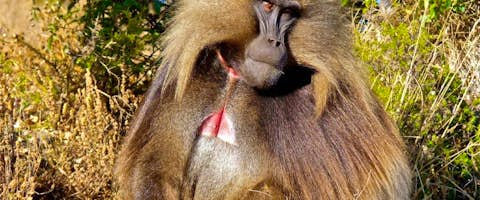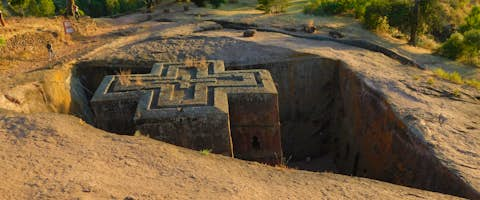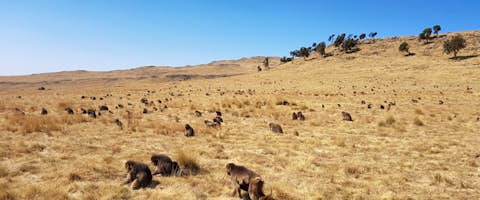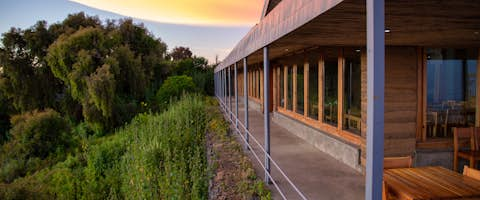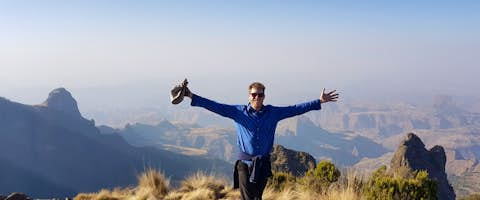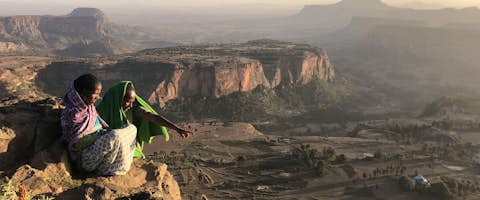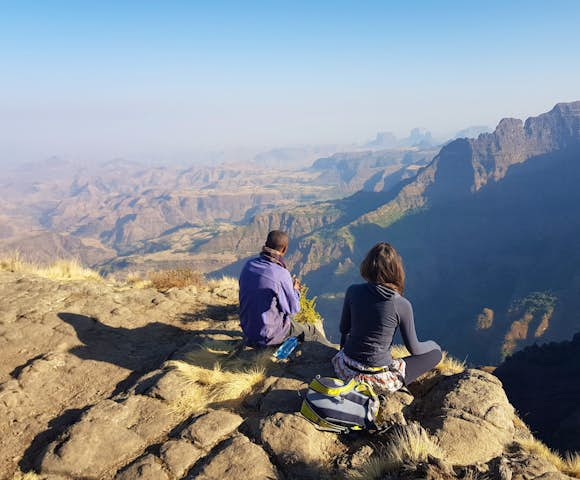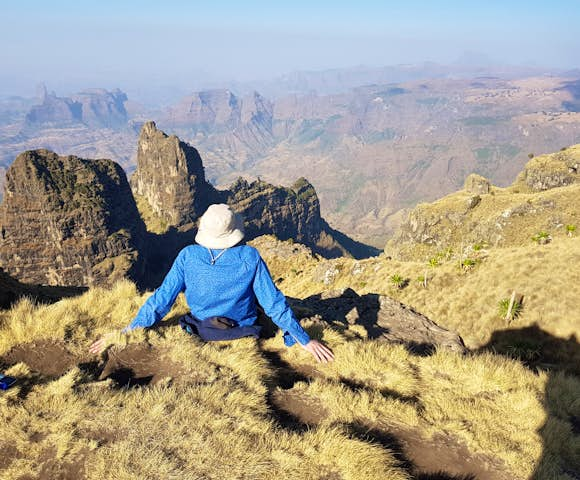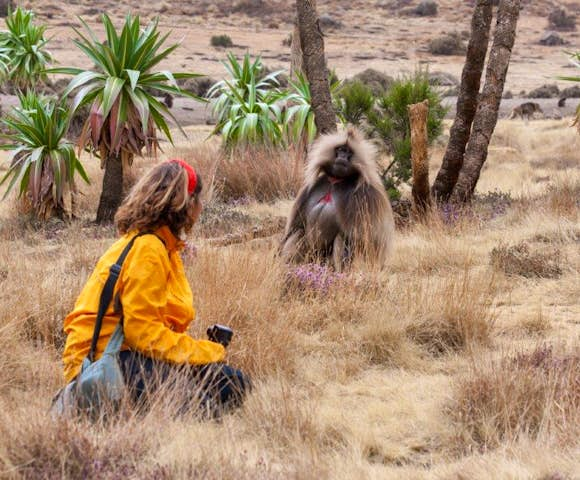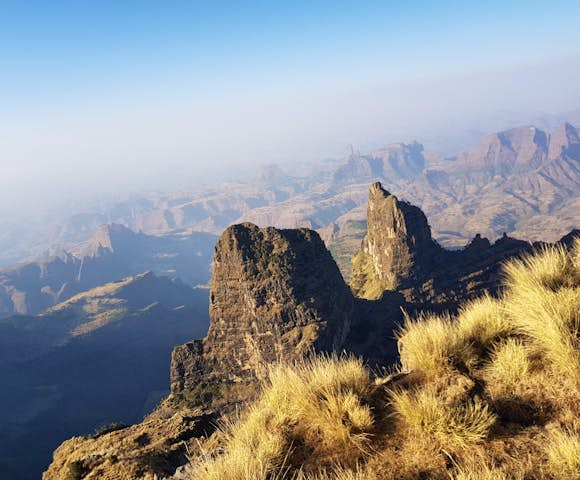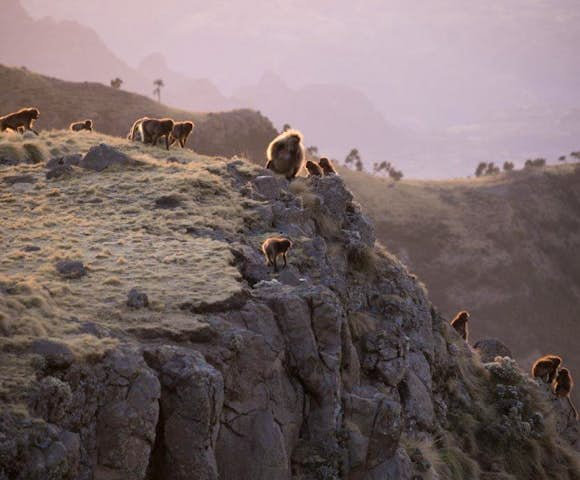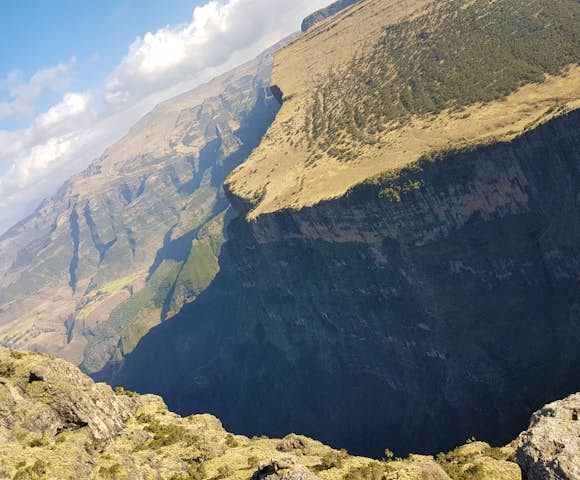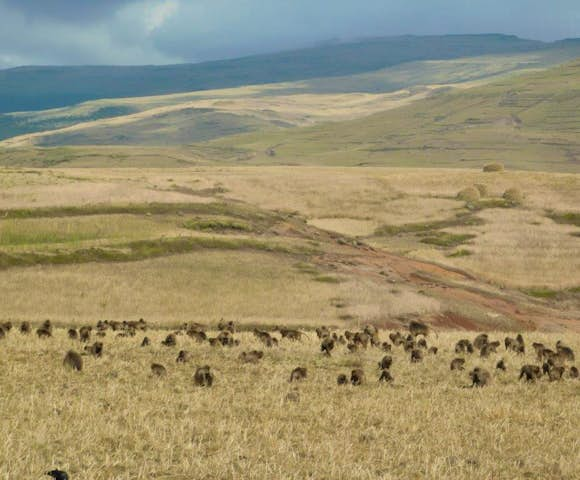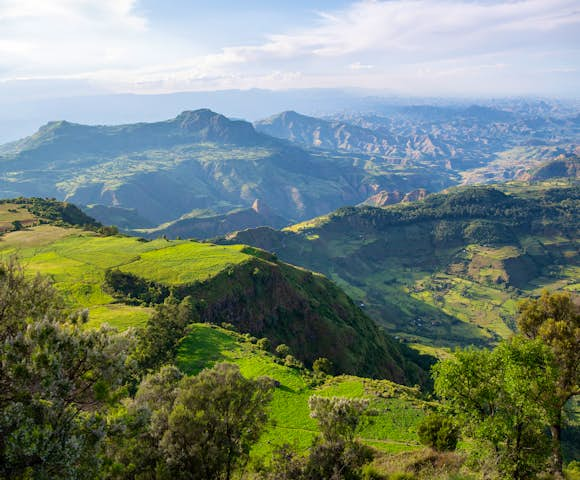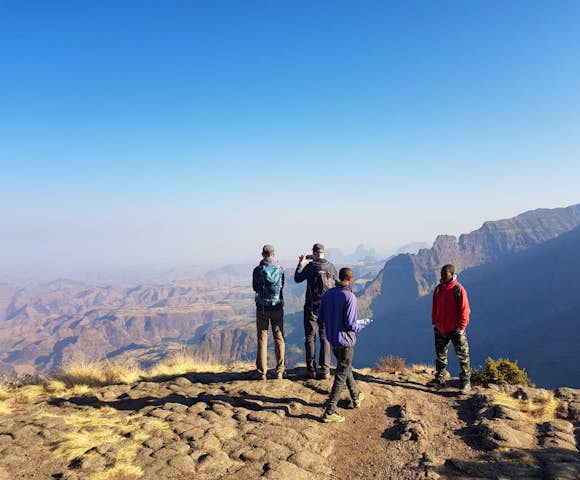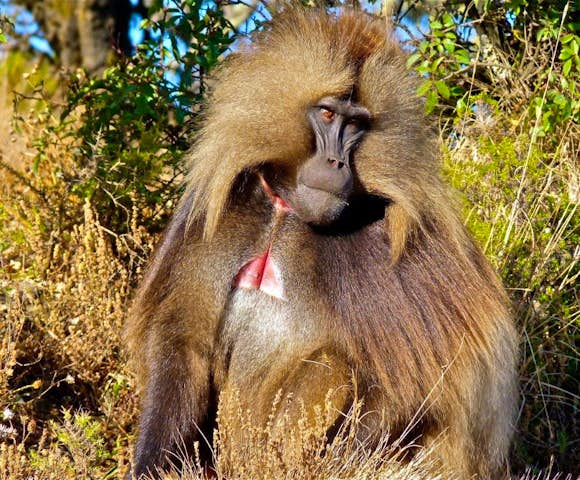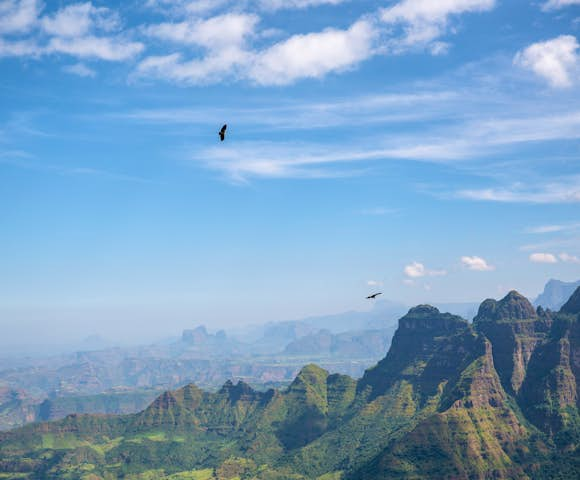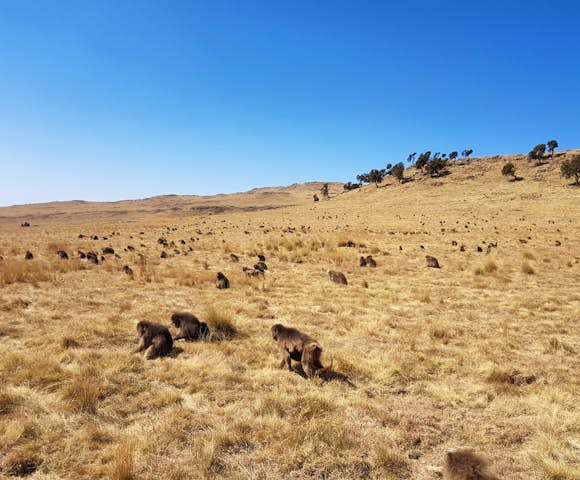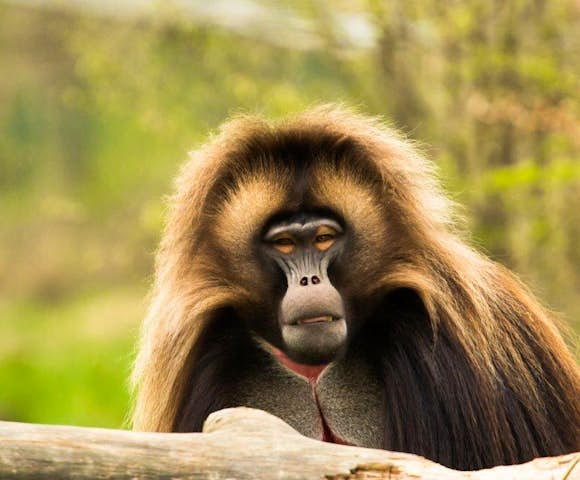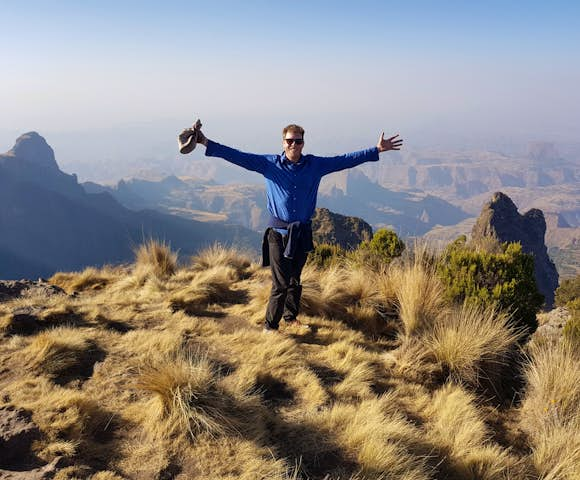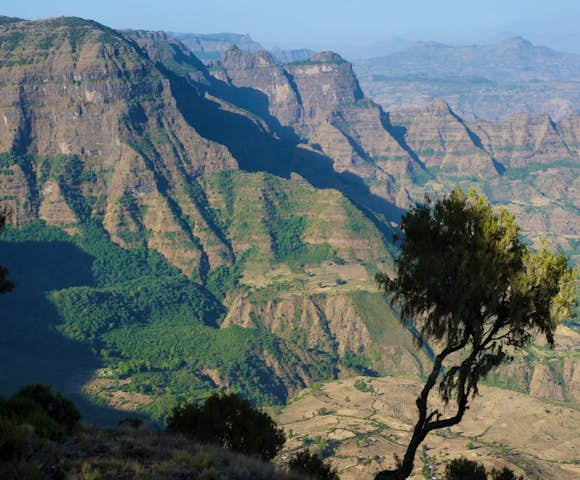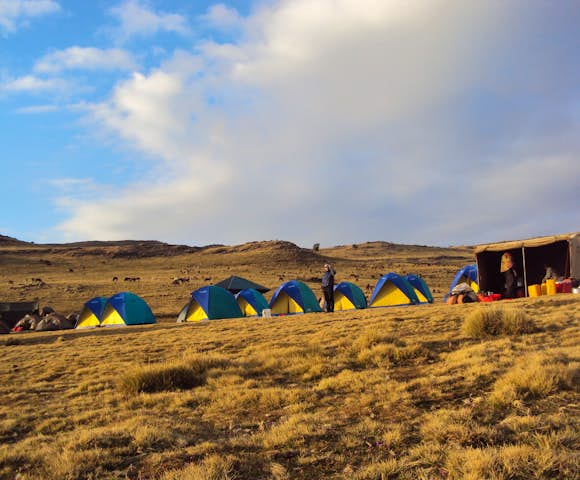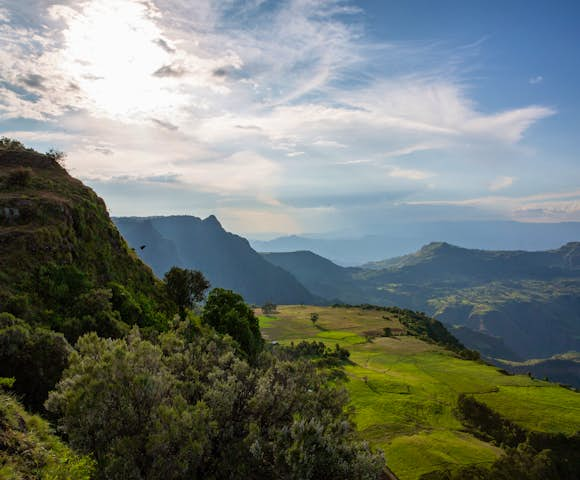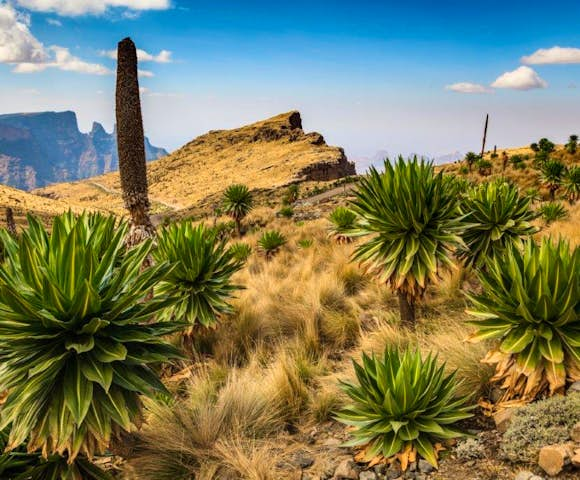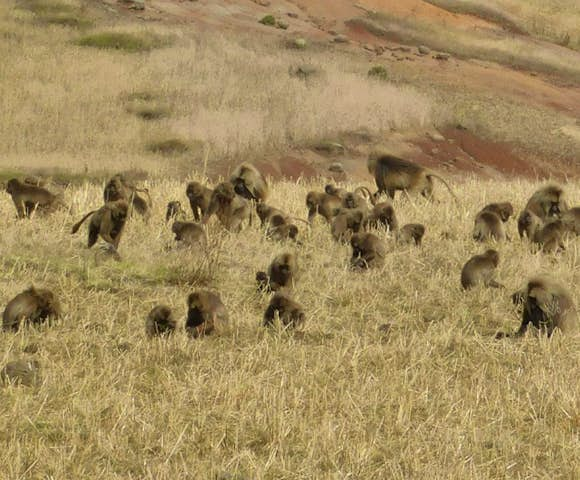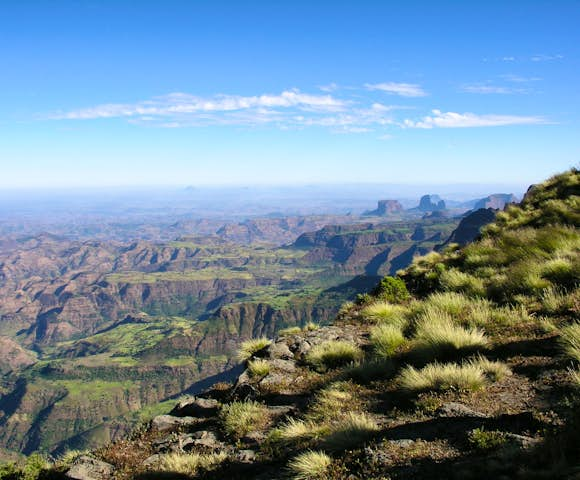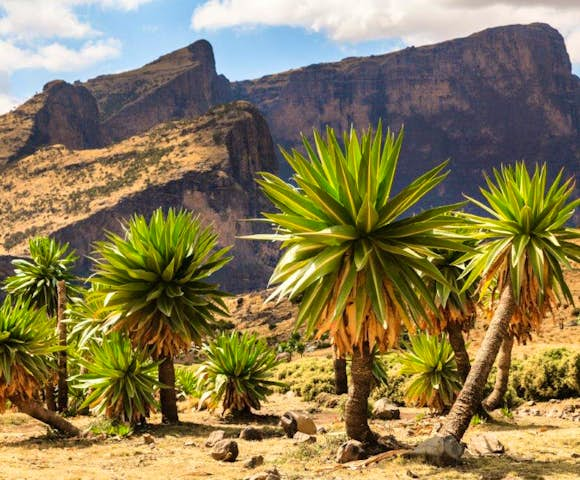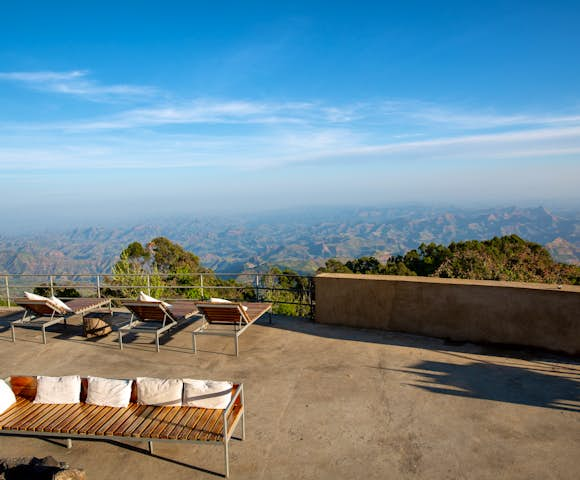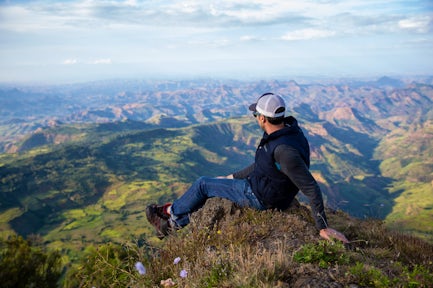Choosing the right trek
It is possible to spend up to two-weeks trekking in the Simien Mountains. Two lodges and nine campsites give you access to the majority of the mountains, and a number of village home-stays to the lowlands north of the park, and to community treks to the south, means there is a huge range of hiking experiences available.
Choosing the right base, duration, and routes can make a big difference to your overall experience in the Simien mountains.
Popular Treks in the Simien Mountains
Trekking Routes in the Simien Mountains
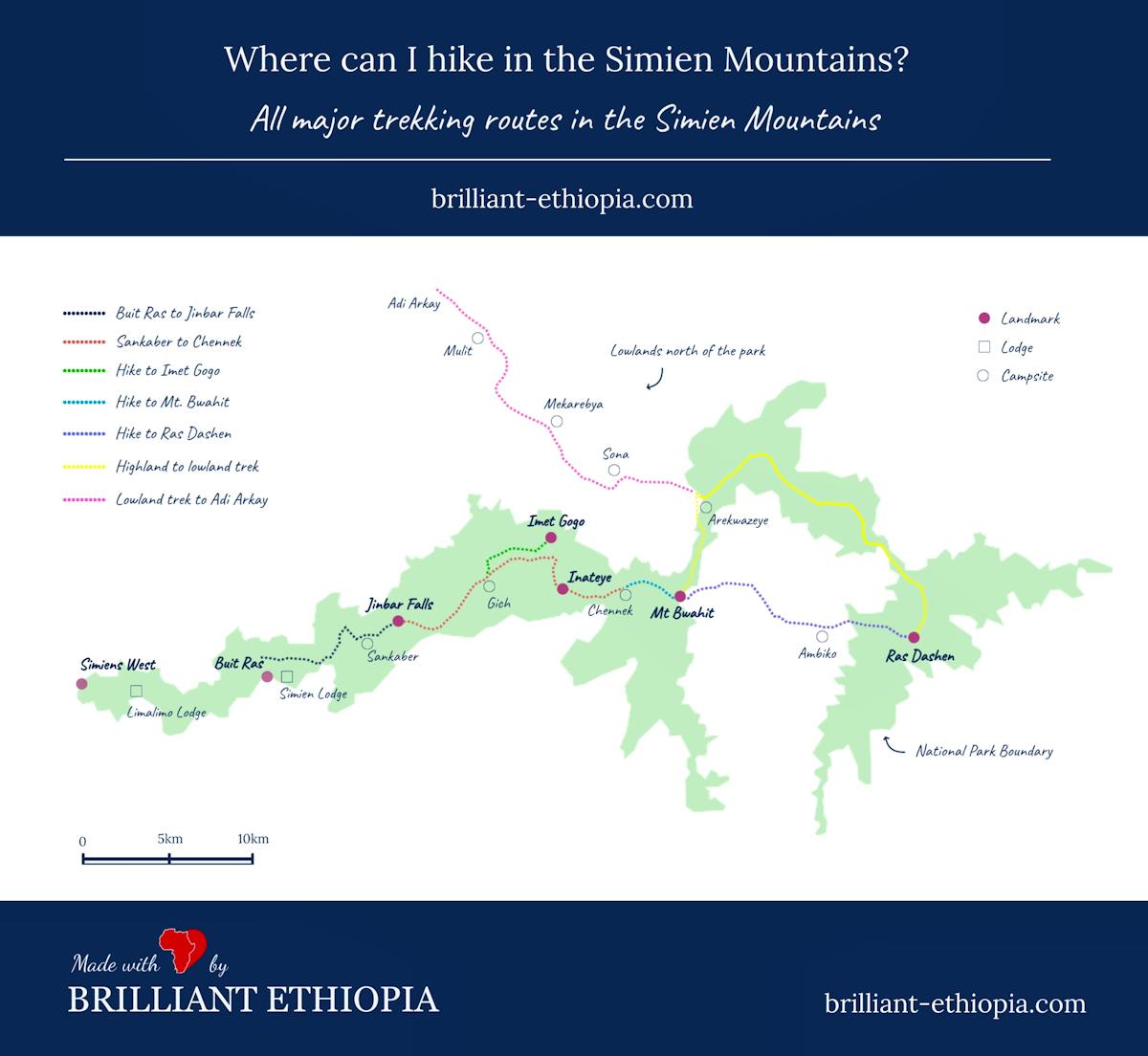
Most Popular Treks
Buit Ras to Sankaber and the Jinbar Falls
If you are camping in the Simiens, Buit Ras will likely be your drop-off point. From here, an acclimatization hike takes brings you to Sankaber, the first campsite for most Simien treks. If you are staying in Limalimo Lodge or Simien Lodge, you can drive directly to the lodges first, and then take a transfer into the park to join some of the trails, or to stop off at the best viewpoints.
A popular landmark on the first day of a Simien trek is the Jinbar Falls, where the Jinbar river plunges 500m down into the Gich Abyss. The waterfall is very seasonal, and particularly impressive in and after the rainy season (July - November). In the drier months, the flow is significantly reduced, but it is still a remarkable sight.
The hike from Buit Ras to Jinbar falls follows relatively even terrain across the escarpment edge with great views. Troops of Gelada Monkeys, sometimes numbering in the hundreds, might be spotted and you can often go and sit near them and watch them as they eat and play. The hike lasts about 3 hours, but can be shortened by vehicle if needed.
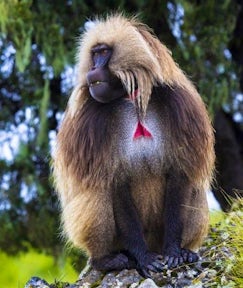
Sankaber to Chennek
Sankaber, Gich, and Chennek connect across the primary escarpment of the Simien Mountains, and a popular trekking option is a 3-night hike from camp to camp. The route across the escarpment has exceptional viewpoints with stunning 360-degree views and lots of wildlife. There are plenty of optional hikes to other peaks, to see wildlife and to take in other landmarks depending on your fitness levels and interests.
Chennek is a highlight of the park. Set in a stunning area with views of the surrounding escarpment and out onto the lowlands for miles into the distance. Chennek is also one of the best places to spot the Walia Ibex and, if you’re very lucky, the Ethiopian Wolf.
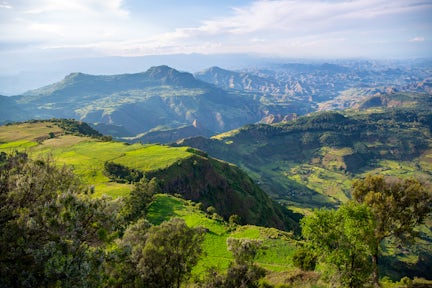
Princess stop and the views around Limalimo Lodge.
Imet Gogo
Imet Gogo, at 3,926m, is one of the most beautiful and popular viewpoints in the Simien mountains. Imet Gogo can be accessed via a somewhat challenging hike from Gich campsite. The summit offers panoramic views of the entire Simien range, and if you look east you will see the towering Ras Dashen (Ethiopia’s highest peak) in the distance.
The trek is about 5-6 hours for the round trip with some steep ascents - it’s one of the highlights of the Simiens, and we’d definitely recommend giving yourself time to include it. The trail begins with a descent hike that takes you down into the Jinbar river valley, before ascending up towards Imet Gogo, finishing along a ridge with exceptional views on both sides.
Check out the video we took from Imet Gogo below...
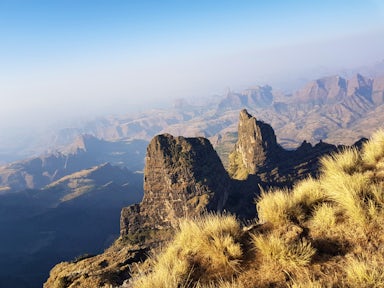
Views from the Simien Mountains.
Inateye
Inateye is a wonderful viewpoint accessed on the approach trek from Gich to Chennek. Inateye sits at 4,070m, and has amazing views of the Bwahit pass to the east, Imet Gogo to the north, and the surrounding escarpment. Inateye is a hot-spot for birds; raptors soar in the thermals below and you’ll likely also find tawny eagles and lammergeyer here. From the summit of Inateye, it is a 3-hour onward trek to Chennek.
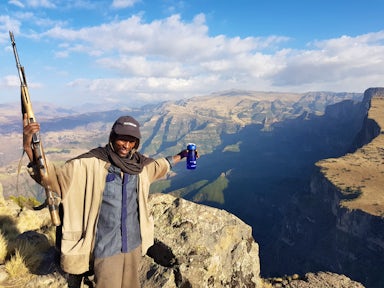
An armed scout must accompany you in the Simiens.
Challenging Peaks
Bwahit Peak
Bwahit is the highest peak on the western side of the Simiens at 4,430m (second only to Ras Dashen, which stands just 110m higher). The trek starts from Chennek and takes 4 hours for the round trip. Although shorter in distance than many of the other Simien trails, the altitude can make the hike quite challenging.
Chennek is the best spot in the park to see Walia Ibex, and your chances of seeing them are much higher if you’re trekking all the way to Bwahit peak. The route to Bwahit passes sprawling fields of Giant Lobelia trees, and as you ascend above the clouds, the terrain often becomes covered by a mist.
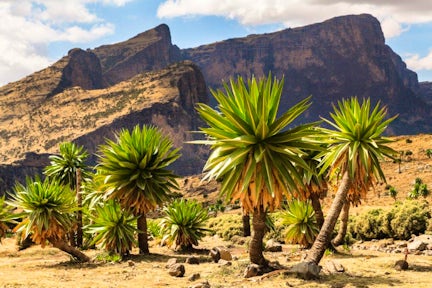
Lobelia trees encompass the Chennek campsite.
Ras Dashen
The Ras Dashen summit hike is the most challenging trek in the park. It is not possible to hike to Ras Dashen via sortie into the park from a lodge as the peak sits to the east of the primary escarpment and so you need to camp at the base camp at Ambiko.
The full trek can last up to 12 hours, with around 7 hours for the ascent hike and 5 hours for the descent hike. While there are some steeper gradients, the majority of the trail follows a relatively even ascent, but the ever-increasing altitude and the overall duration of the hike makes it very challenging. You will need to be quite fit for this hike.
Standard treks to Ras Dashen will start and end in Ambiko. With our partners, we can arrange more adventurous routes taking you down a different trail.
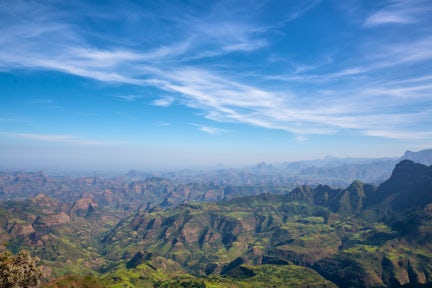
The sprawling, jagged, epic Simien landscape.
More Peaks in the East
For those who want a challenge, there are some high peaks on the eastern side of the park. Ras Dashen is the most famous of these, but a close second is Kidus Yared (4,453m). A number of other peaks in this area can be considered subsidiaries of Ras Dashen and Kidus Yared.
For a challenging hike, you can start a trek from Ambiko to Rash Dashen, then hitting Kidus Yared before a ridge walk takes you to the craggy peak of Abba Yared (4,409m), and then descending to the camp at Arekwazeye. If you are exceptionally fit and start early, you might also manage to hit the peak of Silke (4,420m) too.
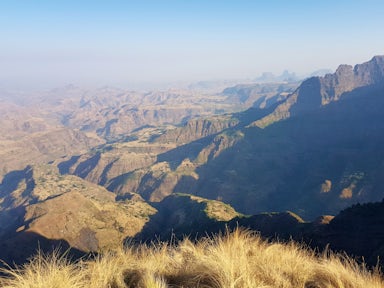
On a clear day, the views are an amazing display of light and shadow.
Further Afield
Treks north towards Sona
For those spending 7+ days in the park who plan to complete the full Simien circuit finishing at the lowland village of Adi Arky north of the park, there are two routes that follow the escarpment edge towards Sona, where the lowland trekking begins.
The first route is shorter and runs from Chennek or Mount Bwahit north towards the campsite at Arekwazeye. The second route follows from Ras Dashen in the east of the park and skirts the escarpment edge all the way around to join at Arekwazeye. This trail is about 7 hours and there are some fantastic viewpoints along the route, including Kidus Yared, Silki, Waliakend, and Berochwuha.
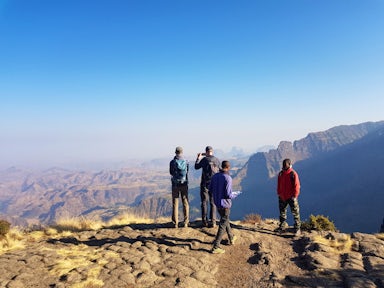
View from Imet Gogo - day 2 of the Simien trek.
Lowland Treks from Sona
To the north of the park, a series of campsites and village stays run through a rural countryside towards Adi Arkay, the northernmost village of the Simien circuit and the finishing point for the lowland treks.
Hiking here is a very different experience than in the highlands of the main escarpments, and it is a wonderful way to learn about the local way of life and meet local people, whilst enjoying the incredible views and starry nights. Temperatures along the trail are much warmer due to the lower altitude, making the evenings more pleasant.
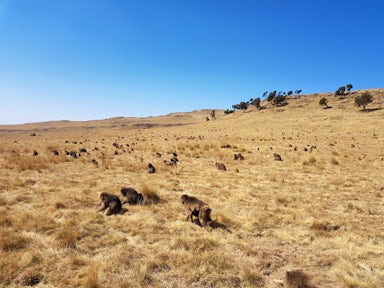
Geladas racing across the open fields near Sankaber.
Community Trekking
If you are a trekking enthusiast, or keen to see the local farming culture in the highlands, you can spend a few days on a community trek in the Simiens.
Set in the farm land just south of the park, you are hosted in simple huts built by the locals just outside their village. Your bedrooms, round tukuls, have mattresses on raised bases. There are simple sit on latrines with plastic seats, and the locals prepare basic meals for you. You will have local trekking guide (generally okay English).
Don't expect a lodge, it is basic and remote, but you will experience the genuine hospitality of the highlanders. This can be dovetailed with a visit into the main park itself - but both are very different and equally fantastic experiences. The community trek is ideally a 4 night trip and supports the local communities who own the guesthouses.
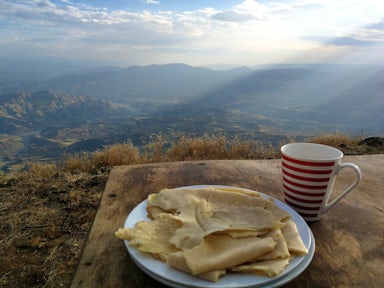
Arranging Permits & Scouts
All visitors to the Simien Mountains National Park must first stop at the entrance town of Debark to collect permits and arrange your guide and scout services. It is mandatory that a qualified guide and scout accompany you while trekking in the Simien Mountains (all of this will be handled for you as part of your booking with us).
Debark is your final stop before entering the national park, so it is a good idea to stock up on any essential supplies here. There are a couple of ATMs in the town if you need to withdraw some cash.
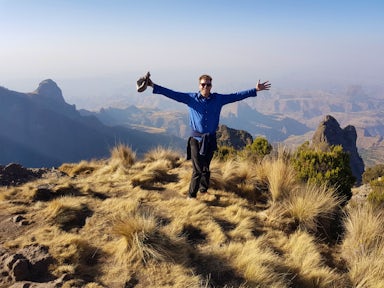
Tom on the 'Roof of Africa'.
When to visit the Simien Mountains
The best time to visit the Simien Mountains is between October and March, with the clearest skies and warmest weather. December, January, and February is the peak travel season, meaning the campsites could be busy, but you have the best weather conditions (although changes in climate patterns mean the rainy/dry season is less reliable so you should be prepared for rain at any time). The rainy season in the northern highlands of Ethiopia runs from June to August, with showers often extending into the first half of September.
You can learn more on our ultimate guide on when to visit Ethiopia.
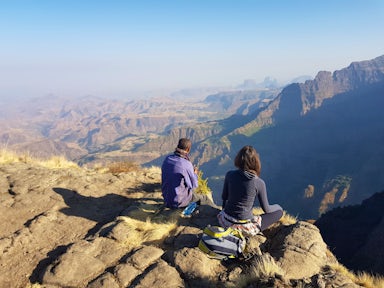
Taking a break to admire the view.
Trekking in the Simien Mountains FAQs
-
Do I need to worry about altitude sickness?
Altitude sickness is a real possibility in the Simien mountains, although instances are rare for most visitors with some experience at higher altitudes. If you have a history of altitude sickness or other pre-existing health conditions that may put you at higher risk, please consult your doctor or travel health nurse to help determine whether the Simien mountains are an appropriate for you.
It is important to be aware that the Simiens are in a rural part of the country, and the nearest health facility is many miles away by road. You must arrange adequate travel insurance before departing to Ethiopia, and consult your doctor to understand the risks involved for you.
Staged increases in altitude is extremely important to avoid altitude sickness. It is important that you do not fly into Ethiopia and immediately head to one of the higher camps. It is much safer to acclimatise in Addis, Gondar, or Lalibela for a few days before heading into the Simien Mountains.
-
How fit do I need to be?
Trekking in the Simien mountains is not limited to the super fit or athletic. A road running through the primary escarpment of the mountains allows you to take sorties into the park, and simply stop off for short hikes to the best viewpoints and landmarks.
Guides can also help to carry gear or show you the most accessible routes. While you don’t need to be in amazing shape to enjoy the Simien mountains, it is important to keep in mind that you will be above 3000m most of the time, so even short walks can become tiring.
For those that are fit and active, there are some more challenging treks you can enjoy if you want to push yourself.
-
What do I need to bring?
Please see our full Simien trekking kit list below:
The essentials
- Waterproof jacket/raincoat/windbreaker and jumper for the evenings.
- Good quality, robust, waterproof trekking shoes or boots.
- Light waterproof trekking pants or trousers. Shorts are a good option as well on warmer days.
- Sunglasses.
- Sunscreen.
- Soft day bag (backpack).
- Toilet paper and/or wet wipes.
- Comfortable T-shirt. If you're visiting in the rainy season, a long sleeve trekking T-shirt (ideally Dri-FIT or similar) is a better option.
- Cap or hat.
- Filtration water bottle (please don't use plastic).
The nice-to-haves (guides can provide much of this for you)
- Earplugs.
- Umbrella.
- Binoculars.
- Sleeping bag.
- Torch.
- Nordic walking stick.
- We also recommend bringing a few sachets of rehydration salts. Water is provided for the treks but you can often find yourself dehydrated after a full day of trekking and the salts can provide quick relief.
The different operators offering trips into the Simiens have different standards - it’s well worth booking one of the better ones to ensure you have the right gear and good food on your trip.
Tents, sleeping bags and mattresses can vary in quality depending on who you choose and with sub-zero temperatures, poor gear can make things uncomfortable.
- Waterproof jacket/raincoat/windbreaker and jumper for the evenings.
-
What equipment do I need?
If you are camping in the mountains and have booked a trip through Brilliant, then all camping equipment and food will be provided for you for your treks. However, we do recommend that you bring your own sleeping bag, or check your gear before leaving Debark to ensure you’ve plenty of what you need. Sometimes the sleeping bags, or mattresses can be thin for some people and you might want to bulk up on blankets or double up on gear.
Given the altitude, the temperature in the Simiens often drops below freezing at night and the equipment you have can make all the difference between an enjoyable or an uncomfortable stay. You should definitely also bring warm clothes for the evenings and night-times.
Your main luggage can be stored securely at a hotel in Gondar if you are returning there after your Simien trek, or you can keep them in our vehicles if you are not returning to Gondar. Where this is not possible, luggage is transported by mules from camp to camp, so it is easier if you bring soft bags rather than hard suitcases.
If you are staying at a lodge, then all your luggage can be stored securely at the lodge and you can simply take out a day bag with you on the treks.
-
Do I need to bring any specialist equipment?
No, the trekking routes in the Simien mountains are not technical - so as long as you have the basics you will be fine. Walking sticks and ankle supports can be helpful if you are able to bring them, or need them.
-
Where should I stay?
There are two lodges in the park and nine campsites. You can therefore choose camp-only treks, lodge-only treks, community-run treks (south of the park) or a combination. Which is best for you will depend on your fitness levels, interests, budget, and time constraints. For more information, check out our guide to choosing the right accommodation in the Simien Mountains.
-
How long should I spend in the park?
The most popular trip is a 2 or 3-night stay based at either Limalimo Lodge or Simien Lodge, or camping from Sankaber to Chennek over 3 nights (often with a night or two at Limalimo Lodge tagged on at the end if you have more time available). The full Simien circuit from Buit Ras all the way to Adi Arkay in the north can take up to two weeks.
It is possible to do a day trip into the park, but the experience is more limited. You can see the large troops of Gelada Monkeys, and get to see some of the stunning viewpoints, but you will spend a lot of the day on the road starting out the windows of a Toyota Landcruiser.
It is possible to climb Ras Dashen with a 5 day/4 night trip, but it's tough going and does not give you much time to adjust to the altitude. The trekking team will also charge a minimum of 8 days for this trip.
-
Do I need a guide?
It is highly recommended. It's sensible to book ahead as if you just show up you will get whichever guide is available that day, and many are not as professional or knowledgeable as you would like.
If you are visiting independently, it is not mandatory to take a guide (although you will be pressured into taking one). However, it is mandatory that a scout accompanies you in the mountains. If you visit independently and go with a scout only, you will face a language barrier as scouts tend to have very little English.
If you are coming with a tour operator, then a guide and scout is mandatory.
There are detailed regulation as to how many cooks, cook assistants, scouts, guides etc. a group must take - there are even position like 'tent erector'! You will have quite a team accompanying you, your muleteers and mules!
All visitors to the park must first arrange entrance fees, guides, and scouts at the entrance town of Debark. If you book through us, all of this is taken care of for you.
-
How much does it cost?
Given the variety of treks and accommodation options available, the price for a Simien trek depends mostly on the whether you choose to stay at a lodge instead of camping, and how long you want to spend in the park. Get in touch with us for more details or to arrange a quote.
-
Can I combine the Simiens with other destinations?
Absolutely. The Simien Mountains is part of the classic northern circuit of Ethiopia. Ethiopian Airlines’s domestic flight network makes it easy to connect into the gateway town of Gondar from anywhere in the country, and from there it is a 2-hour drive to the national park.
Although not always included in the northern circuit, it is also easy to combine the Simiens with a trip into the Danakil Depression.
If you want to combine the Simiens with regions in southern Ethiopia like the Omo Valley or Bale Mountains, keep in mind that you need at least 4 days to explore the Omo Valley, and 2-3 days for the Bale Mountains. If you're combining these destinations with the full northern circuit, you'll need at least two weeks.
-
Are meals & water included?
If you are on a camping trip, all meals, water and snacks are included. However, in the interest of the environment we are trying not to use packed bottled water. This will also save on the size of your mule train! We recommend that you bring filtration equipment (a small filtering water bottle or pump). The team can then just bring a jerrycan or two and even fill up from the natural spring water (and it is safe if you have a filtration system).
At Limalimo Lodge, all meals and mineral water are also included. Note that the menu is fixed but they will adapt to your requirements if you tell them in advance). Limalimo have their own filtered water and bottles of local drinks. Wine from the Rift Valley (highly recommended!), beers, and local G&T are also included. If you are staying at the Simien Lodge, food and drink are not included but there is a good a la carte menu for each meal.
-
What is the weather like?
The Simien’s rainy season starts in June and runs into the first half of September. The best months for trekking are from October to March. Check out our guide on when to visit the Simien Mountains for more information.
-
Is the park suitable for families?
Absolutely. Short, kid-friendly hikes can easily be arranged. If you are coming as a younger family, it usually makes more sense to base yourself at Limalimo Lodge or Simien Lodge. Older children used to camping will enjoy the adventurousness of the treks and time around the campfire in the evenings.
Camping in the Simien Mountains
There are nine major campsites in the Simien Mountains. The most popular, Sankaber, Gich, and Chennek sit along the primary escarpment of the park. A typical trek starts from Sankaber and winds across the escarpment to Gich and then on to Chennek. The route from Sankaber to Chennek itself is extraordinary, with many fantastic viewpoints along the way. If you want to push yourself, there are also a number of optional hikes to some higher peaks.
For those who want to spend longer in the park, do some tougher trekking, or simply experience more of what these mountains have to offer, there are a further seven campsites beyond Chennek which will often be less busy than those on the main routes. These take you far beyond the primary escarpment, across the Bwahit Pass towards Ras Dashen, and then out northwards towards Adi Arkay across the lowlands and rural farmland.

Sankaber campsite - the first stop on the classic Simien trail.
Campsites in the Simien Mountains
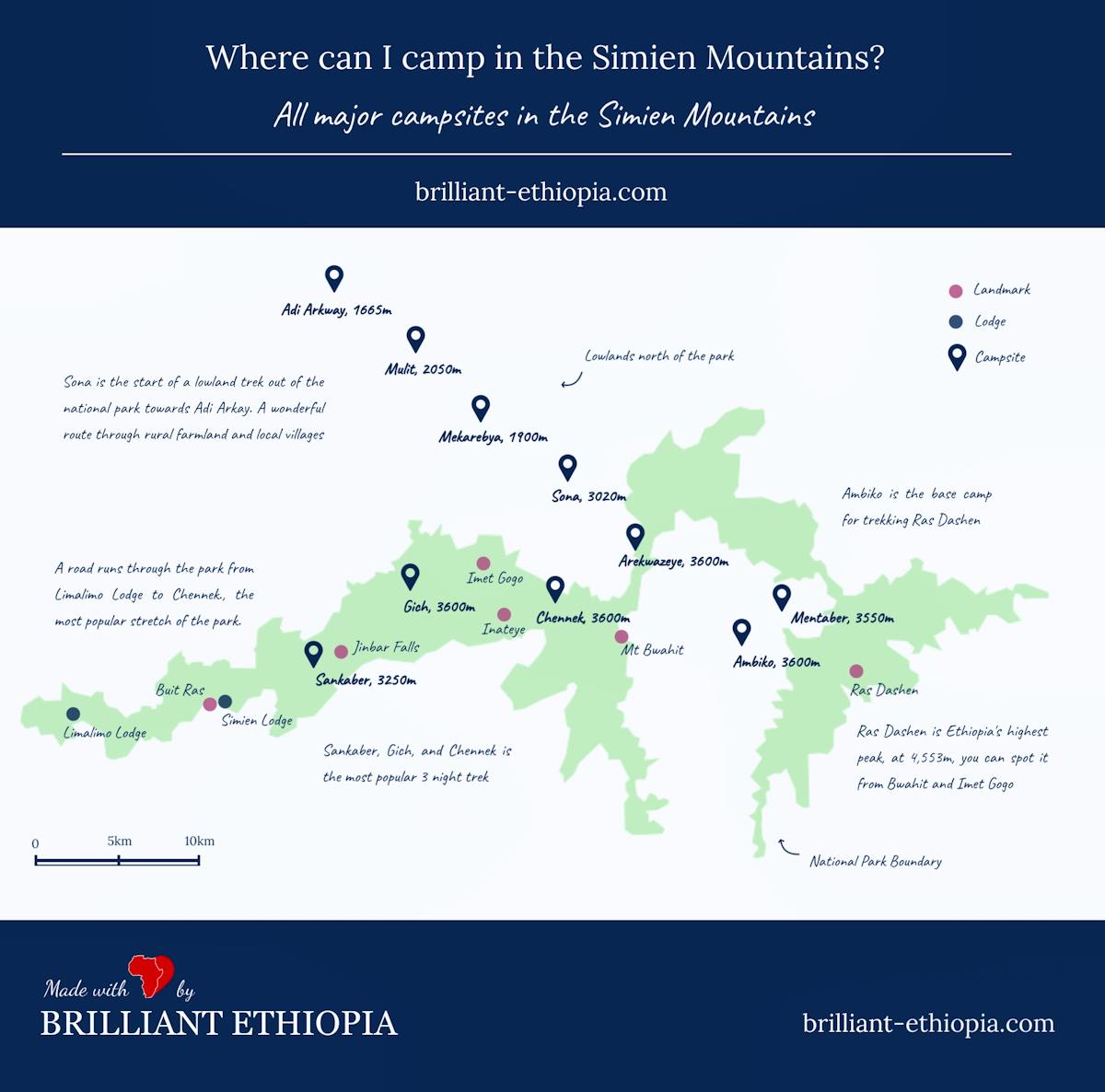
Should I stay in lodges, campsites or community guesthouses?
With two lodges and nine campsites across the park, as well as three community guesthouses just south of the park, there are many ways to experience trekking in the Simien Mountains. Which base is right for you will depend on your fitness levels, interests, budget, and time constraints.
So, what are you looking for?
-
A day hike or self trek
If you are limited on time but want to get an impression of the Simiens, it is possible to head into the mountains for the day, departing from Gondar in the morning and returning in the afternoon. While you will see some of the best viewpoints thanks to a road that runs through the main trail, you need to be prepared for a busy day. In total, it is a ~6 hour round trip from Gondar to the Simien Mountains (once you have factored in the mandatory stop at Debark to pay your entrance fee and arrange your guide and scout). In total, you will have about 4-5 hours in the park.
If you have a little more time to spare, it is well worth heading first to Limalimo Lodge or Simien Lodge and spending the afternoon enjoying the self-treks around the lodges. The following day, you can spend a full day in the park before returning to Gondar. This spreads the journey to and from Gondar over two days, giving you more time to enjoy the park.
-
A 2-3 night stay in the outdoors
If you like being in elements and have 2-3 nights to play with, the classic 3-night trek from Sankaber to Chennek is a fantastic option. 2-3 nights gives you plenty of time to hit the major viewpoints and landmarks, and there are a number of trekking routes you can choose from depending on your level of fitness and how much you want to push yourself.
-
2-3 night stay in comfort
If you want to experience the majesty of the Simien Mountains without compromising on comfort, your best option is to base yourself at either Simien Lodge or Limalimo Lodge and take sorties into the park from there. The Simien Lodge sits deeper into the park itself, which makes it slightly better for self-trekking around the lodge. However, Limalimo Lodge is fast becoming the default base for those who want lodge-stays in the Simiens, simply because of its attention to detail, service, and luxury aesthetics.
From both Simien Lodge and Limalimo Lodge, you can get as far into the park as Chennek via a road running through the primary escarpment. It takes about 2 hours to get from Limalimo to Chennek by car, and the road is very bumpy.
-
A mix of adventure and R&R
One of the best ways to explore the Simien Mountains is via a mix of camping and lodge-stays. For a typical 3 night trek, you can spend the first 2 nights camping at any two of Sankaber, Gich, and Chennek, before spending the last night relaxing at the luxurious Limalimo Lodge. The number of days you spend camping versus at lodges can be flexed depending on how long you have available (we recommend having at least 2 nights at Limalimo).
-
To challenge myself
The Simien Mountains have some of the best trekking routes anywhere in Africa. With nine campsites spread across the entirety of the park, it is possible to spend up to two weeks trekking the mountains. Access to some of the best and most challenging treks require overnights camping. In particular, Ras Dashen and Mount Bwahit are best hiked from their base camps.
Consider climbing the big three: Ras Dashen (4,553m), Kidus Yared (4,453m), and Bwahit (4,430m).
With our fantastic partners, we can even arrange treks from the lowlands from Lalibela up into the Simiens with overnights at community guesthouses, and then on into the core of the park.
After any of these adventures, a closing night or two at Limalimo Lodge is a great way to reward yourself.
There are many ways to see the Simiens and we can also help arrange cycling trips, or longer stays for those looking for more adventure.
Lodges in the Simien Mountains
Trekking in the Simien Mountains is not limited to those willing to camp. There are two lodge options: Limalimo Lodge and Simien Lodge which can make for a much more comfortable stay - it gets cold at altitude in the park, particularly at night when temperatures often drop below freezing which can make even the hardiest of campers pause.
Both Limalimo and Simien Lodge are high-demand, low-capacity lodges -so its worth booking well in advance to secure rooms.
Limalimo Lodge charges more for their rooms, but all meals are included. Simien Lodge charges for theirs, so the costs of the two lodges are comparable. Of the two, we’d recommend trying Limalimo first as it’s the newer and more luxurious of the two.

Sunrise in the Simiens from Limalimo Lodge.
Limalimo Lodge
Limalimo Lodge is fast becoming the default way to explore the mountains, or as a comfortable stop off at the beginning or end (or both) of a camping trip. It’s a beautiful eco-lodge built on the edge of the western escarpment just inside the park with exceptional views. Your room fee includes meals (some of the best served food in northern Ethiopia), and drink (we recommend the local Rift Valley wines!).
A community-led lodge with just 14 rooms all built with local materials and excellent service - Limalimo is often booked up well in advance.
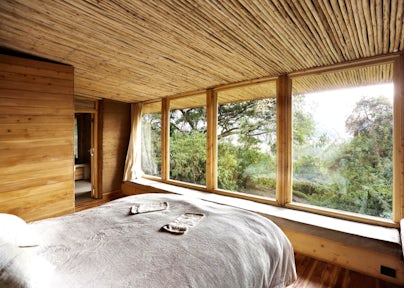
Cosy, cabin-esque rooms at Limalimo Lodge
Simien Lodge
Simien Lodge is the original lodge in the park - famous for being the highest lodge in Africa at 3260 metres, it sits inside the park and is a great base for treks along the primary escarpment towards Chennek, and for self-treks around the lodge.
It is also a great place to wander around and see some of the biggest troops of Gelada baboons playing on the ground and the surrounding fields - they are quite habituated to tourists in this area so you can get up close to them.
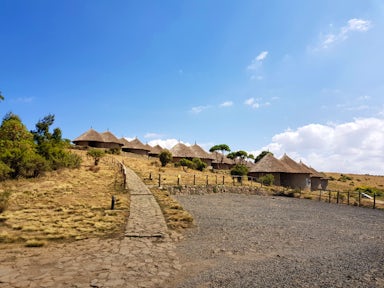
Accommodation in Debark
During peak season, it is not uncommon for both Limalimo Lodge and Simien Lodge to be fully booked. If you don’t want to camp, you can stay overnight at a hotel in Debark, the entrance town to the Simien Mountains. Debark is a small town and the accommodation options are limited and not very good quality.
The best options are the Ras Dejen Hotel or Jeramba Hotel. Staying in Debark is the cheapest way to explore the Simien Mountains, but it is a 1-hour drive into the park from Debark (and a further 2 hours if you want to go as far as Chennek).
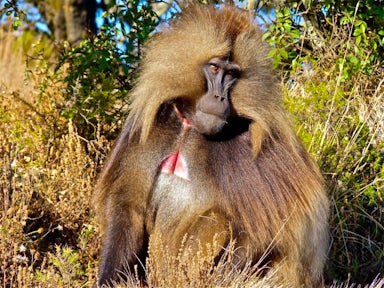
The 'bleeding heart' Gelada Monkeys - symbol of the Simiens.
Campsite and lodge opening times in the Simien Mountains
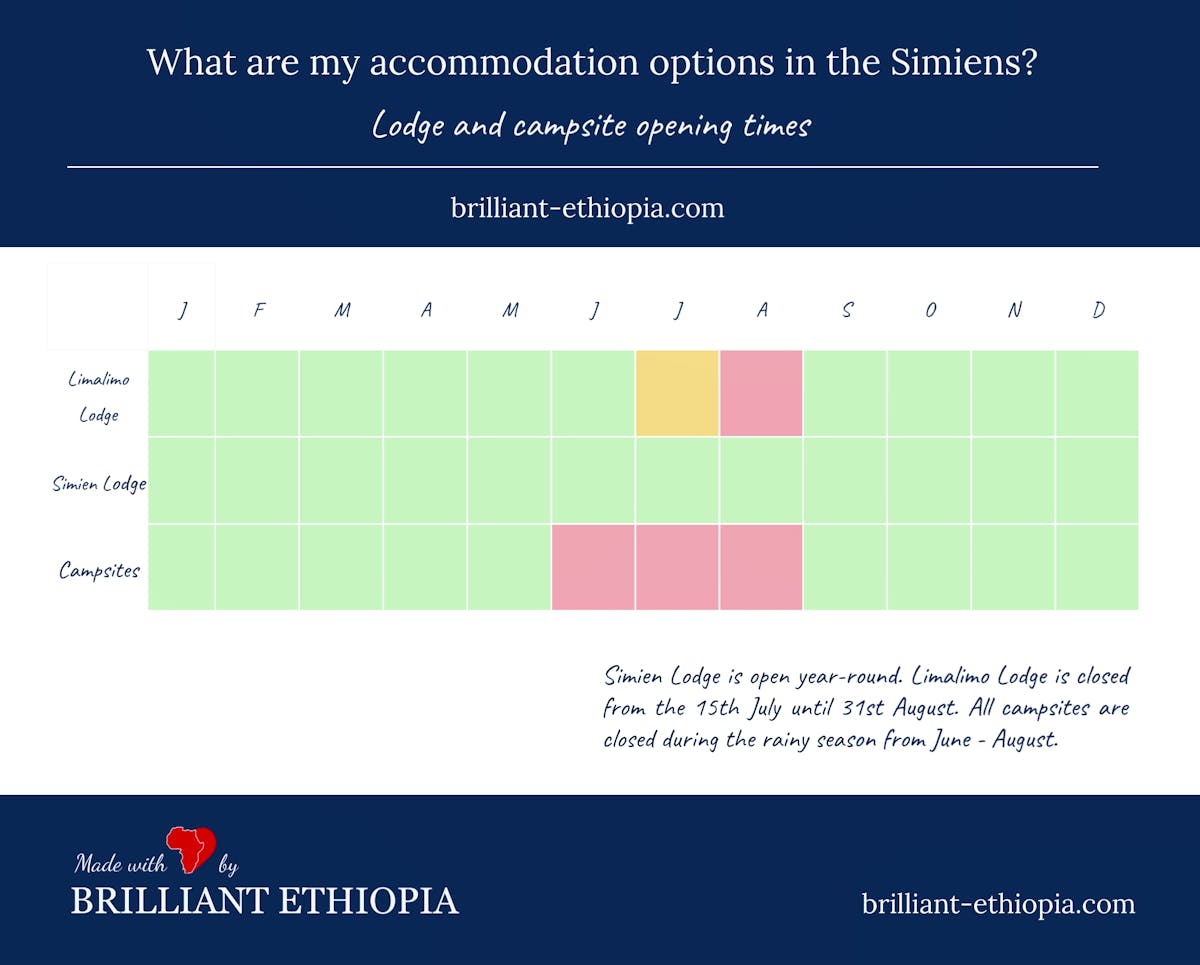
How to get to the Simien Mountains
The Simien Mountains National Park are in the Amhara region of northern Ethiopia. The nearest airport town is Gondar, so most visitors will reach the Simien Mountains via a domestic flight into Gondar, followed by a 2-hour drive to the Simien Mountains. Ethiopian Airlines' domestic flight network makes it easy to get to the Simien Mountains from most parts of the country.
How do I get to the Simien Mountains?
-
From Addis Ababa
Ethiopian Airlines run a reliable and comprehensive domestic flight network, with routes to all the major towns in the north and south of the country. The easiest way to get from Addis Ababa to the Simien Mountains is via a short domestic flight to Gondar, the nearest major town to the Simien Mountains. From Gondar airport, it is 103km (a ~2 hour drive) to Debark, the entrance town to the Simien Mountains National Park and the park HQ.
You will be required to stop at Debark to collect the necessary documentation and pick up your guide and scout. From here, a further 1-hour drive takes you into the park itself.
It is not possible to drive straight from Addis to the Simien Mountains in one day - you would need to stop for an overnight en route. We’d recommend flying, if possible.
-
From Gondar
Gondar is the gateway town to the Simien Mountains. Gondar is 95km (1.5 hours) from Debark. It is a scenic route along the northern highlands (the Kossoye viewpoint is particularly spectacular on the road to Debark and worth a quick visit). The (former) Falasha village, Woleka, makes for an interesting stop.
-
From Bahir Dar
From Bahir Dar, you can reach the Simien Mountains by air or by road. By road, it is a 3-hour drive to Gondar and then a further ~2 hours to the park (4 hours in total from Bahir Dar to Debark). In most cases, driving is the quickest way to get to the Simien Mountains from Bahir Dar.
There is no direct flight from Bahir Dar to Gondar, so if you travel by air you will need to connect through Lalibela. It is a 30-minute flight from Bahir Dar to Lalibela, and another 30 minutes from Lalibela to Gondar. From Gondar, it is a ~2-hour drive to the Simien Mountains.
-
From Lalibela
-
From Mekele
There is no direct flight from Mekele to Gondar, so if you travel by air you will need to connect through Lalibela. It is a 30-minute flight from Mekele to Lalibela, and another 30 minutes from Lalibela to Gondar. From here, it is a ~2 hour drive into the park.
While it is possible to drive from Mekele to the Simiens, it is a long 9-hour drive.
-
From Axum
The best way to get from Axum to the Simien Mountains is by road. It is 250km - a scenic 5-8 hours from Axum. The journey is slow going up into the switchbacks of the Simiens mostly on un-asphalted roads but the views are good. It is possible to access the Simiens by air, but the net journey is longer than driving directly.
-
From Harar
From Harar, it is a ~75 minute drive to the airport town of Dire Dawa. From here, you can catch a domestic flight to Addis (55 minutes) and connect with a flight to Gondar (65 minutes) to begin the ~2 hour drive to the Simien Mountains.
In most cases, it wouldn’t make sense to put the Simiens right before or after a visit to Harar. You might want to break up the trip with visits to other destinations.
-
From the Omo Valley
If you’re coming up from the Omo Valley, the quickest route back into the north of the country is via a domestic flight via Addis. The best options are a flight from Jinka to Addis (55 minutes) or from Arba Minch to Addis (65 minutes). From Addis, you will connect with a domestic flight to Gondar, followed by a ~2 hour drive into the mountains.
Another option is to drive from the Omo Valley up through the Rift Valley, breaking up the journey with overnights along the great lakes of Ethiopia before arriving in Addis and flying up to Gondar.
-
From the Bale Mountains
If you’re coming from the Bale Mountains, you will need to connect to Gondar via Addis Ababa. You can reach Addis with a 50-minute flight from the nearby Robe airport. Alternatively, you can head to Addis via a drive along the Great Rift Valley, spending a night or two by the great lakes to break up the journey.
From Addis, it is a 65-minute flight to Gondar followed by a ~2 hour drive from Gondar to the Simien Mountains.

Brilliant says
The best itineraries sequence destinations to maximise enjoyment and minimise frustration. If the scenery is exceptional, a long road trip can be a better option than a short domestic flight. Finding the balance between experience and logistics requires some thought, and we’re always happy to help.
Popular Trips to the Simien Mountains
Ready to plan your Ethiopia adventure?
Listen
We'll spend some time listening to your aspirations, then discuss the kind of experience that might suit you.
Match
Next we'll discuss the options, shortlist the best trips for you and present you our impartial recommendations.
Reserve
We'll place a 24 hour hold on your preferred option - without obligation - whilst we talk through the details.
Whatever your budget, group size, length of stay, preferred activity or appetite for adventure, we can help.
+1 315 645 2889



